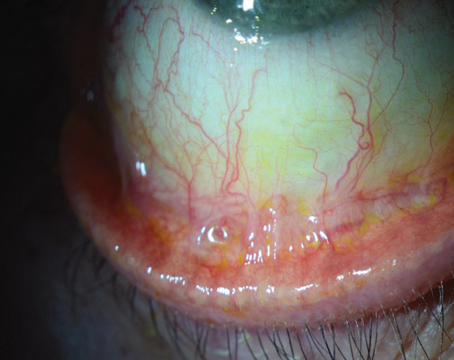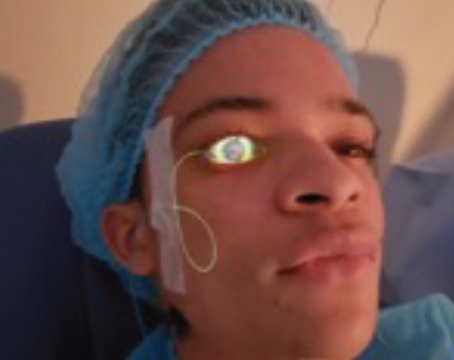The renowned historian and author Daniel J. Boorstin famously said: " … the greatest obstacle to discovery is not ignorance—it is the illusion of knowledge."
Consider how appropriate this is in our understanding of keratoconus.The more we have learned about this condition in recent years, the more reason we have to question what we thought we knew. In this article, I hope to use the recent work of my colleagues and others not to solve the mystery but to challenge the consensus about the disease, to add another set of questions that I hope will move the discussion forward and help us remove the obstacles to discovery regarding keratoconus.
The Dots That Need Connecting
Cornea specialists have long asked themselves, what happens to our older keratoconus patients?1 How real is my perception that more KC patients should be returning among our large group of "over 70" patients? In fact, KC was a common indication for young patients to undergo penetrating keratoplasty 20 to 25 years ago. So where are these middle-aged and elderly post-PK patients today? KC patients are told they have a genetic condition, and then a significant number of them want to know why they are the only one in their family with this problem. I reassure them that it does not mean they were adopted. The textbooks and classical teaching list a number of conditions associated with KC such as Down's syndrome, Ehler's-Danlos syndrome, Leber's Congenital Amaurosis and atopy. Are these associations primary with a genetic link, or do they represent a secondary association in response to environmental or behavioral factors (secondary to the eye rubbing associated with these other conditions)?
There are a host of unanswered questions with regard to KC. Consider the eye-rubbing controversy: Is eye rubbing merely a phenomenon observed within those patients considered to have both KC and allergic eye disease, or is this something more integral to KC and its progression? Does KC cause eye rubbing? Does eye rubbing cause KC?
What role does eye rubbing play in compensating for a vision or surface-related problem caused by KC? Does unilateral KC truly exist, or do these patients represent highly asymmetric cases of bilateral disease? How do we account for the enormous variability we routinely encounter with these patients? Consider, for example, the age of presentation, rate of progression, and the asymmetry between eyes. Why do KC patients have better Snellen acuity than non-KC patients with similar levels of uncorrected astigmatism—as though they have learned to compensate when processing image signals from visual "noise" caused by aberrations? Is KC an isolated corneal disease or is it perhaps a syndrome, not isolated to the cornea? Is it better represented as a condition of inherited vulnerability or susceptibility (altered dose-response curve to mechanical trauma such as eye rubbing)? Is post-LASIK keratoectasia linked to KC beyond the simple explanation that early, or forme fruste cases escape diagnosis and unfortunately undergo further weakening by LASIK surgery? Why do some patients develop post-LASIK keratoectasia despite having a minimal score by risk-factor analysis? Is "aging" the cornea with collagen cross-linking really the best way to go, and are there other factors we should be addressing in these patients that might help slow down or halt the progression of this condition?
The Danger of Complacency
In medicine, when we have treatment options that are reasonably successful, our efforts tend to shift away from better understanding of the fundamental disease process. This is certainly the case with KC. We have been told for decades how successful corneal transplantation is relative to that of other organs in the body and that patients receiving a graft for KC tend to do even better relative to other PK patients with respect to rejection rate. Hence, our attention and clinical effort are increasingly directed toward earlier diagnosis and the application of newer keratoplasty procedures (IEK) as well as other recently developed treatment options including Intacs, DALK, and collagen cross-linking (See Figure 1). Meanwhile, we develop a complacency around our perception of adequacy and success despite the many unanswered questions and our continued poor understanding of the etiology and pathophysiology leading to progression of KC.
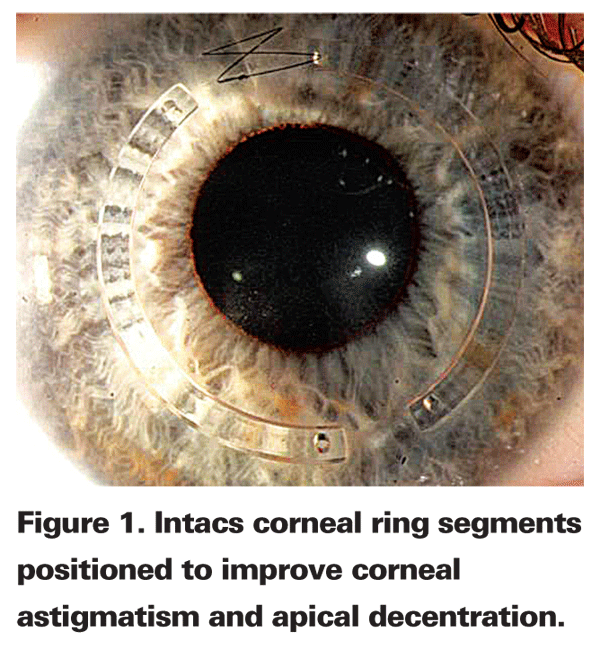
KC is thought to represent a genetic disorder with a poorly defined pattern of inheritance leading to central corneal thinning, progressive steepening, irregular astigmatism, and a host of other slit-lamp findings, depending on its severity. Considering the genetic basis for this disease, why do only 7 percent of patients report awareness of other family members with this condition? This may be because KC is a complex genetic disease that requires interaction with environmental factors to make a genetically determined predisposition clinically apparent. Consider the hypothesis that KC includes a genetically altered dose-response curve to eye rubbing. If the corneal changes are more readily apparent in the eye rubbers, then KC could be more widespread genetically within the same family that includes "genetically positive" non-eye-rubbers. This could also make it difficult to find an adequate control group when trying to investigate genetic patterns of inheritance, as subclinical disease could reside in the non-eye-rubber.
The major textbooks mention eye rubbing in anecdotal terms suggesting an observed association, connected mostly to allergies and possibly contributing to those more severe cases that develop acute hydrops. For the most part, this association is presented as genetics at work in the keratoconic cornea of patients who share a genetic association with allergies and on this basis, they have a predisposition and propensity toward an allergic pattern of eye rubbing. Under these conditions, the features of eye rubbing should be less pronounced in KC patients who do not have allergies. Also, in those patients having both allergies and KC, the eye rubbing should largely mimic the eye rubbing seen in purely allergic patients. On closer examination, however, this does not appear to be the case.
Distinguishing Eye Rubbing
All eye rubbing is not the same. Eye rubbing performed by the purely allergic patients is fairly straightforward. It is in response to allergic symptoms which patients consistently report as "itching." There may be a few other descriptive words but itching is far and away the leading response. In fact, when asked about eye rubbing, allergic patients are highly aware of their behavior and a typical response might be, "when my eyes itch, I rub them and if they didn't itch, I wouldn't rub them." KC patients are very different in this regard.2 While they may have allergies and their symptoms can certainly overlap with allergic complaints, their observations often include comments not typically associated with allergies. The motivation behind their eye rubbing may include itching as a complaint, but unlike the allergic patient, they often report a number of other reasons such as, "burning" or "it just feels good" or commonly, "I need relief." KC patients also describe motivating factors for eye rubbing that are never offered by the purely allergic patient, such as, "It helps me see better." Previous studies have demonstrated the ability of warm compresses with pressure to temporarily produce thinning of the corneal epithelium.3 However, it is unclear precisely what mechanisms are invoked by the eye rubbing KC patient to gain this perceived improvement in vision—whether it is a temporary alteration in surface topography or more likely, an improvement in the quantity, quality and distribution of surface lubrication.
Allergy vs. Keratoconus
Upon further observation, not only is the perceived need to rub different, but the timing, contact method, pressure applied, duration, motion, location over the lid and the derived benefit are all remarkably distinct between these two groups. KC patients, even when they have allergies, offer identifiably distinctive eye rubbing characteristics that stand out in comparison to the allergic patient. For example, the purely allergic patient, in response to allergic itching, generally begins by using a flat instrument (back of hand, front of hand or palm; See Figures 2 & 3) applied broadly, rubbing back and forth, horizontally over the eyelids generating eyelid movement and pressure and "traction" within the lid itself with only modest pressure transmitted to the cornea. This is often followed by a transition to using the tip of the index finger as allergic rubbing tends to migrate nasally, concentrating point pressure over the caruncle for the follow through and completion of the effort. Added contact pressure is then applied at this stage when the caruncle is being rubbed and a circular component may also be added to the motion after this transition to the caruncle (See Figure 4). Patients with long fingernails adjust their angle of attack and apply this last portion most commonly with the ball of their index finger. This may be relatively short and seldom lasts longer than 15 seconds. The KC patient, on the other hand, has a limited number of favorite techniques, the majority of which begin with a pointed instrument, either a knuckle (middle knuckle more commonly than distal or proximal knuckle; See Figure 5) or finger tip(s) (See Figure 6).
The hallmark of the KC rub is the circular motion of this point-like pressure confined over the cornea, often with pronounced pressure transmitted posteriorly—much more than with the allergic rub (apart from the allergic caruncle rub). The intensity and duration (10 to 180 seconds, up to 300 seconds) are much greater in KC patients, as is the repetitive nature. The perceived benefit and relief reported by the KC patient is different from the relief from itching sought and achieved by the allergic patient. Interviewing these patients "in action," the KC patient is more likely to elucidate an experience of ecstasy and euphoric rapture during and toward the completion of the rub, wanting to do even more. The purely allergic patient describes the process as filling a need, wishing he did not have to do this, and in the end reports more of a "mission accomplished."
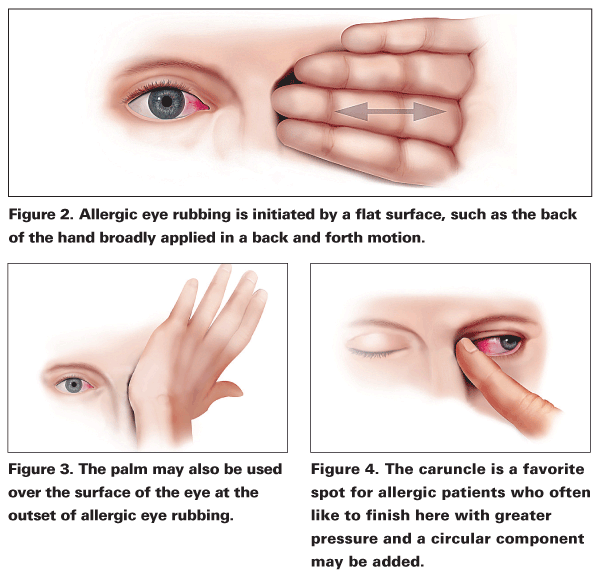
Eye rubbing also incorporates complex patterns of behavior. There are profound distinctions between these two groups even extending to the accuracy with which patients report their eye rubbing activities. The "itch-rub-itch" cycle in the allergic patient is simpler to explain as a clinical response to an allergic challenge. Allergic patients are highly aware of these episodes and tend to be fairly accurate when reporting their symptoms, as well as the frequency and severity of eye rubbing, in response to these allergic challenges.
In contrast, KC patients often under-report eye rubbing when first asked about it, perhaps reflecting a desensitized awareness as this repetitive behavior or habit becomes increasingly incorporated into their daily routine. This habitual nature of eye rubbing may be exposed by handing a patient a tissue while distracting him during an interview; this is best performed before bringing up any questions about eye rubbing. Patients will often spontaneously blot or rub their worse eye while they are talking to you, often unaware that they are doing this. I have had patients deny eye rubbing during an interview in which they unknowingly demonstrate their tendency to rub.
Scratching the Itch
KC patients may also exhibit repetitive and even ritualistic behavioral tendencies compounding the physical need they feel to rub their eye. This can include profound eye rubbing at certain times of the day or associated with specific activities such as immediately after awakening or after removal of their contact lenses. This can be even more severe if they are alone and uninhibited. The timing for this eye rubbing after contact lens removal is not simply a pent-up level of desire that is repressed while the contact is in but continues to build until fully expressed when the contact is removed.
Patients learn to avoid eye rubbing while wearing a contact lens, yet there is something additional here that occurs immediately after the contact is removed. Interviewing and examining these patients supports that this pattern of behavior is not attributable to eyelid or conjunctival allergy. Rather, it appears directed at a stimulus derived from the cornea or from the interaction between the eyelid and corneal surface in the absence of a contact lens. While eye rubbing facilitates lubrication and the interaction between the eyelid and the corneal surface in the absence of a contact lens, I also wonder if contact lens removal improves oxygenation to corneal nerves that are stretched and stressed from KC but also somewhat hypoxic after contact lens wear. This improvement in oxygenation immediately after contact lens removal might initiate a pain signal that responds favorably to eye rubbing—perhaps in the same way that the gate-control theory of pain explains the benefits of acupuncture or therapeutic massage. Relative hypoxia from eyelid closure and the need for better surface lubrication are both factors that might also explain why some patients report early morning as another favorite time to rub their eyes. Eye rubbing may also be incorporated in behavioral tendencies associated with obsessive compulsive disease (OCD) as some of these patients reveal these tendencies in other activities in their life. Interestingly, it is not uncommon for KC patients to report their eye rubbing more accurately when they return for a follow-up visit, noting that it was called to their attention either by the eye doctor raising the question during the first visit or by family, friends or co-workers the patients might survey with regard to their behavior. Another reason for under-reporting this behavior is an embarrassment that some of these patients feel; they may have been chastised growing up or told over the years to stop rubbing their eyes by their peers or by those in authority. For these patients, it is like nail biting, and when asked to demonstrate their eye rubbing technique, they will often blush and remark on the embarrassment this brings.
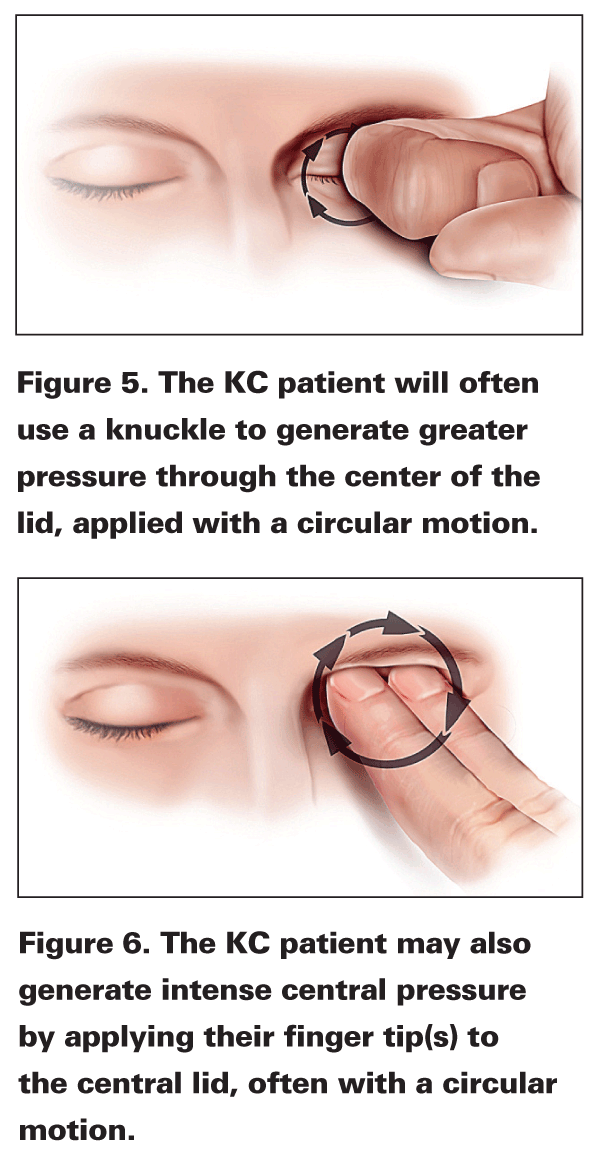
How Sleep Positions Contribute
The most clinically challenging patients with respect to eye rubbing, however, are those who deny it initially and repeatedly deny it on follow-up examination, stating that their family, friends and co-workers all confirm that they are not eye rubbers. What I have found in these patients is a tendency toward putting pressure on or around the more severely affected eye while they sleep at night. This was brought to my attention when I investigated two separate patients who had evidence of KC that was completely unilateral, isolated to only one eye. Both patients admitted that their sleeping position was exclusively on the affected side and involved a hand position that placed considerable pressure on the eye itself. Since those initial two patients, I have made a number of additional observations including the consistent tendency for patients to sleep on the side that is more severely affected or progressing more rapidly. Some of these patients like to sleep with their hand or fist directly against their eyelid (See Figure 7) and are more likely to hug their pillow in a manner that generates some compression around their eyes (See Figure 8). While some generate substantial pressure—in effect, grinding their eye into the pillow—even the milder forms of pressure can deliver considerable cumulative effect over time. Adding further to this is the thermal impact of compressing a pillow against the closed eyelid, reducing the normal dissipation of heat.
My observations support that these patients with asymmetric KC are also more likely to develop floppy eyelids to a greater degree on their sleeping side. More recently, I have identified a surprising number of patients with previously undiagnosed obstructive sleep apnea (OSA), a condition that may lead to a host of cardiac and pulmonary problems, hypertension, esophageal reflux, weight gain and shortened lifespan. Some KC patients develop OSA symptoms prior to acquiring their weight gain, further supporting the need for a heightened sense of awareness among clinicians who may otherwise overlook this condition. I recommend having a low threshold for referring these patients to a sleep lab for formal study if they report restless sleep, snoring, periodic apnea, daytime restlessness, unexplained hypertension or any of the other symptoms commonly associated with OSA. For those patients already diagnosed with OSA, one should be aware that their favorite sleeping position may be altered by their need to wear a CPAP or BiPAP mask, some of which require patients to sleep on their back to maintain an adequate seal. We are exploring this association with OSA further as we try to investigate what might be behind the perception that KC is less prevalent among our patients with advancing age.
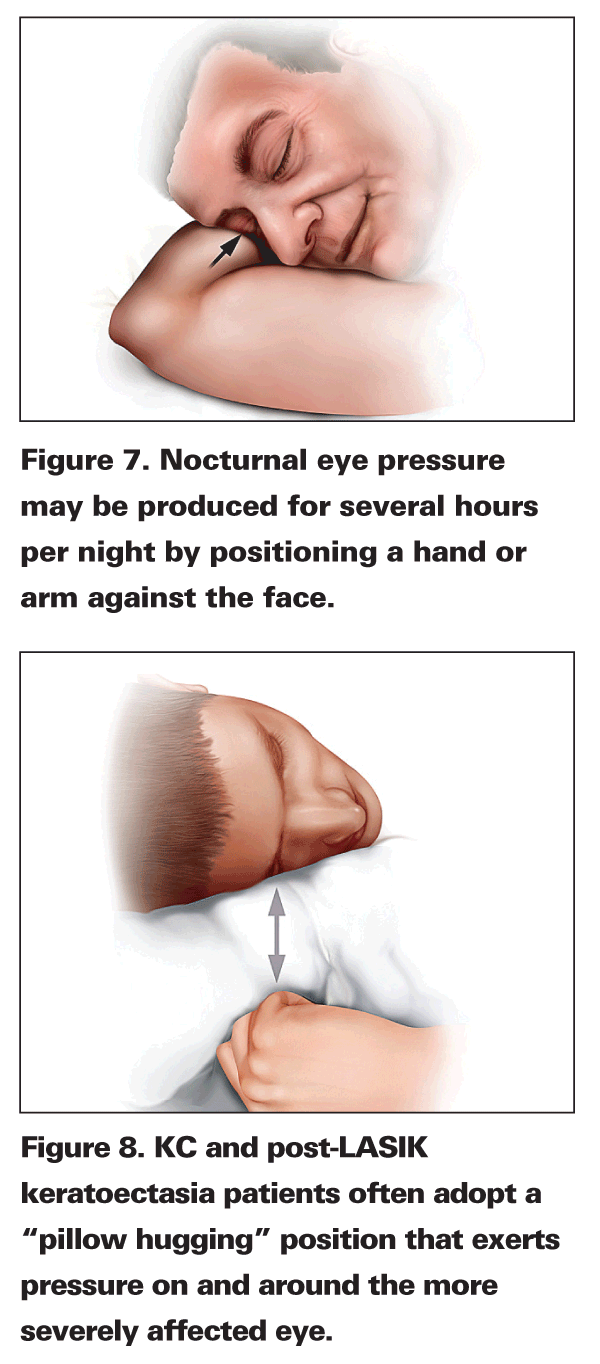
In a previously reported study, we observed a link between KC and obesity. (Kristinsson JK, et al. IOVS 2003;44:E-Abstract 812) Our study compared patients over a three-year period undergoing keratoplasty for KC (53 patients) with age-matched controls (34 patients) undergoing keratoplasty for corneal scarring. Patients undergoing PK for KC weighed an average of 31.7 pounds more than our age-matched control group (p=0.015). Comparing body mass index using National Center for Health Statistics, the difference between groups was highly significant (p=0.006). KC patients were 1.6 times (74 percent vs. 47 percent) more likely to be classified as overweight, 2.2 times (53 percent vs. 24 percent) more likely to be classified as severely overweight, and 8.7 times (26 percent vs. 3 percent) more likely to be classified as morbidly obese against our control group. These heavier patients were also more likely to demonstrate a floppy eyelid.
Recognizing the small size of our original study and also that previous attempts to link KC to mitral valve prolapse failed to conclusively identify a connection, I remain cautious about making a formal association here between KC, obesity and OSA until we accumulate further data. Nevertheless, a hypothesis that a subset of KC patients represents a syndrome that includes a floppy eyelid, "floppy" keratoconic cornea, and floppy soft palate leading to OSA is intriguing and worth pursuing as we try to better understand aging and mortality among our KC patients. The perception that KC is a "young person's disease" in our clinic population is intriguing as we try to better understand what happens to our older patients. The recent emphasis on ruling out KC and the risk for ectasia in our younger patients contemplating vision correction surgery contributes to a heightened awareness and earlier diagnosis of KC; however, this still does not fully account for the observed reduction in disease prevalence with advancing age.
Surgical Influence
I have already mentioned contact lens removal as a factor stimulating eye rubbing, which can be severe. Surgical procedures can also alter this pattern of behavior. Patients with Intacs corneal ring segments learn to rub their eyes less because they have an immediate painful feedback that teaches them to refrain from this behavior. Some patients even report specific locations and techniques that cause the segment to shift in a painful manner. One of the unreported benefits of these ring segments may be their ability to reduce eye rubbing in patients with keratoectasia.
One factor implicating a strong link between eye rubbing and KC is that patients usually point to the moreadvanced eye as their favorite eye to rub prior to PK. After PK; however, patients often switch so that the other eye becomes the favorite eye to rub. I used to think this was entirely related to two factors: a) the postoperative instructions admonishing patients against eye rubbing after PK, eventually causing them to unlearn this behavior, and b) the painful feedback from rubbing the surgical eye, similar to the Intacs patients. More recently I have found an additional factor that involves the post-PK eye producing less of a stimulus for eye rubbing. Their need for relief diminishes, further supporting that it is not the conjunctiva or eyelids producing this need to eye rub, in contrast to what we see with allergic patients. Instead, this may be a product of neurotrophism making the dry-eye symptoms of lid wiper epitheliopathy less symptomatic. Alternatively, this may provide added support to the gate-control theory of pain with neurogenic factors originating in the cornea "short-circuited" by vigorous eye rubbing and then dramatically reduced when tissue containing these stretched or altered nerves is eventually removed with PK. Do the prominent corneal nerves seen by slit-lamp biomicroscopy anatomically represent either a response or a contribution to the viscious eye rubbing cycle we see clinically?
The case is strong that eye-rubbing tendencies of KC patients are overall quite distinct from those seen in the purely allergic patient. Interestingly, these same tendencies are seen in a number of patients with post-LASIK keratoectasia. What this means is that there might be controllable factors beyond the initial screening process to rule out early keratoconus and then perform surgery that maintains a statistically adequate stromal bed thickness. While I applaud the work of J. Bradley Randleman, MD, and colleagues on identifying risk factors for the development of keratoectasia after LASIK, we should strive to identify severe eye rubbers as having a preventable contribution to this unfortunate problem.4 In fact, using a risk-factor score card and identifying a patient as low risk could give a false sense of security in the patient who is self-administering profound eye rubbing or nocturnal eye pressure. It may be analogous to the lack of a Hutchinson's sign leading to a false sense of confidence and an under-treated zoster patient. Furthermore, given the recent emphasis directed toward "aging" the cornea using corneal collagen cross-linking to make it more rigid, doesn't it make more sense to also address eye rubbing and nocturnal eye pressure as a source of local micro trauma rather than simply assuming that these patients need a stronger cornea?
'Rubbing' the Surface of Understanding
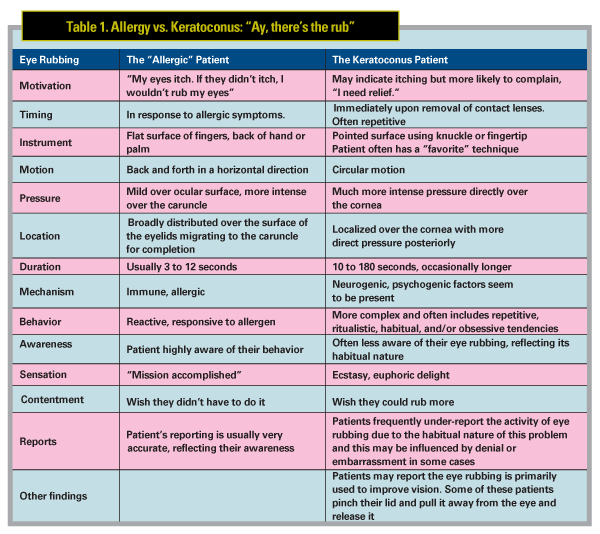
Meticulous examination confirms that KC patients and many of the post-LASIK keratoectasia patients differ substantially from allergic patients in terms of eye rubbing and nocturnal eye pressure. These observations suggest that external microtrauma plays a more integral role in the pathophysiology of both of these conditions. Admittedly, I am making fine distinctions between allergic and KC patients, yet some patients have both conditions. Also, I am not making an attempt here to distinguish the hay fever, vernal and atopic patients from each other, when in fact they have enormous differences in terms of allergic presentation.
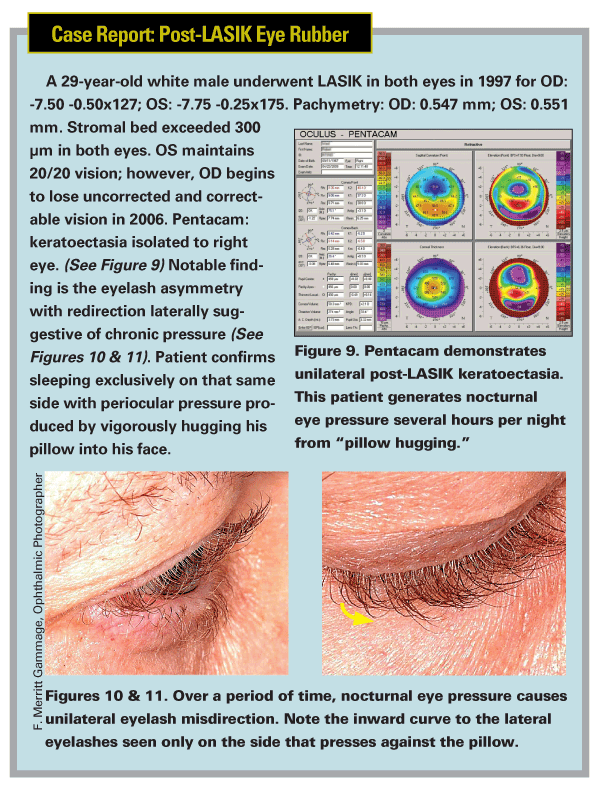
The reality is that KC patients are so magnificently distinct in their eye-rubbing tendencies and behaviors that they stand out as uniquely different from the allergic groups. I believe this will become increasingly apparent to the newly initiated connoisseur of eye rubbing. When was the last time you had an allergic patient tell you, " … when I rub my eyes after I take out my contact lenses, doc, it's better than sex." This type of experience and comment is unique to the KC patient. These are unusual and complex patients and we are still only scratching or "rubbing" the surface. We know that given enough eye rubbing trauma, patients can develop a condition indistinguishable from KC isolated to only one eye. Could this be like the cauliflower ear that develops in the traumatized wrestler? Perhaps the best model for KC is a genetic condition that is particularly susceptible and even accelerated by trauma resulting from eye rubbing or mechanical weakening from LASIK surgery? The observed association with OSA brings to mind a number of plausible hypotheses, the most intriguing of which would be a syndrome that includes KC, floppy eyelid and OSA. Consider the genetically susceptible host with the environmental "second hit" provided as follows: a) eye rubbing or nocturnal eye pressure leading to the "floppy" keratoconic cornea; b) sleeping position and eye rubbing leading to the floppy upper eyelid; and c) the genetically affected soft palate that has a greater propensity for developing OSA due to a greater susceptibility to become "floppy" and obstruct from airway turbulence at lower levels of weight gain. We are sorely in need of better understanding of the etiology and underlying pathophysiology of this condition, despite our present ability to offer newer, better and safer contact lens and surgical options.
Dr. Carlson is a professor of ophthalmology and chief of the Cornea and Refractive Surgery Service at the Duke Eye Center. Contact him at alan.carlson@duke.edu or at (919) 684-5769.
1. McMonnies CW. Where are the older keratoconus patients? Cornea 2009;28:836
2. Carlson AN. Keratoconus. Ophthalmology 2009;116:2036-7.
3. Solomon JD, Case CL, Greiner JV, Blackie CA, et al. Warm Compress Induced Visual Degradation and Fischer-Schweitzer Polygonal Reflex. Optom Vis Sci 84(7):580-587, 2007.
4. Randleman JB, Russell B, Ward MA, et al. Risk factors and prognosis for corneal ectasia after LASIK. Ophthalmology 2003;110:267-275.
